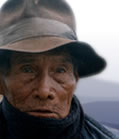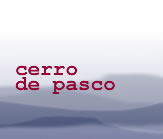The glossary below contains several terms in Quecha, a Peruvian Indian language,
though the majority of words are Spanish.
|
baile viejo
|
the old dance
|
|
baladas
|
ballads
|
|
capesino/a
|
rural people, peasants, people who live off the land
|
|
caņa/caņita
|
rum/shots of rum
|
|
cancha/canchita
|
toasted beans or maize
|
|
centavos
|
cents (old currency)
|
|
centimos
|
cents (current currency)
|
|
champa
|
sod, turf
|
|
charqui
|
dried llama meat
|
|
charquican
|
dish made from charqui
|
|
chicha
|
a mixture of tropical and traditional music
|
|
chicha / chicha de jora
|
liquor made from maize
|
|
baile de los choguinos
|
type of dance
|
|
chuņo
|
potato that has been conserved by freeze drying
|
|
coca
|
South American shrub the leaves of which are used as a stimulant
or narcotic
|
|
cocha
|
lake
|
|
|
paramilitary group presumed to be part of the government
during the 1980s
|
|
compadre
|
godfather of your children, also used as a term of respect
|
|
compaņero/a
|
companion/comrade (male/female)
|
|
comparsas
|
parade of dancers in costume
|
|
comunero/a
|
registered community member (male/female) with rights and
responsibilities (see theme identity)
|
|
conquistador
|
conqueror, refers to the Spanish
|
|
cortamonte
|
festival or dance held in February
|
|
emplomados
|
(literally, people of lead), mine workers
|
|
estancia
|
farmstead, community owned dwelling or hut surrounded by
pastures
|
|
faenas
|
community, communal work
|
|
fiestas
|
festivals, celebrations
|
|
gamonales / hacendados
|
landowners
|
|
gringos
|
westerners, foreigners, in this context North Americans who
ran/owned the mines.
|
|
habas
|
broad beans
|
|
haciendas
|
estate farms
|
|
huaylas/ huaylash
|
traditional dance, fast
|
|
huaylas
|
traditional songs/dances
|
|
huaynos
|
traditional dance, slow
|
|
jala-pato
|
(literally, pull the duck), game
|
|
maca
|
small tuber like a radish, with medicinal properties
|
|
machista/machismo
|
chauvinistic attitudes and behaviour
|
|
maniota
|
lead poisoning in livestock
|
|
mayordomo
|
foreman or master of ceremonies depending on context
|
|
mingas/minka/washka
|
voluntary communal labour
|
|
mote
|
type of maize
|
|
muki / muqui
|
mythical dwarf connected with the mines
|
|
municipio
|
town /local council
|
|
olluco
|
type of crop
|
|
oro
|
gold
|
|
oroyino/a
|
person from La Oroya (male/female)
|
|
pachamanca
|
meat and vegetables cooked in underground ovens
|
|
padrino
|
godfather/sponsor of annual festival
|
|
paisanos
|
fellow countrymen
|
|
pampa(s)
|
grassy plains
|
|
paneton
|
sweet bread eaten at Christmas
|
|
patasca
|
traditional soup
|
|
potatoes a la huancaina
|
potatoes with melted cheese and garlic
|
|
puchero
|
dish eaten with guinea pigs made from potatoes, cabbage and
a little meat
|
|
Quechua
|
Peruvian Indian language
|
|
relaves
|
mining waste
|
|
rompe-olla
|
(literally, break the pot), game
|
|
salsa, chicha, cumbia, baladas
|
types of modern music
|
|
santiago/santiaguito
|
dance during carnival, characterised by a little drum called
a tinya
|
|
senderista
|
active supporter of Sendero Luminoso
|
|
Sendero Luminoso
|
The Shining Path: the main Maoist guerrilla movement in Peru.
Formed in the late 1960s, it was particularly active in the
1980s and early 1990s, and drew much of its support from rural
areas.
|
|
servinacuy
|
cohabiting before marriage
|
|
sierra
|
mountain
|
|
soles
|
Peruvian currency
|
|
tinya
|
little drum
|
|
Vaso de Leche
|
(literally, glass of milk) welfare organisation originally
aiming to ensure all children receive milk daily
|
|
vicuņas
|
animal prized for its wool; nowadays shearing of its wool
is prohibited
|
|
ya
|
"okay"
|


